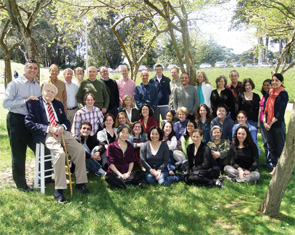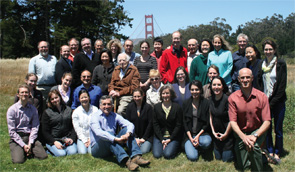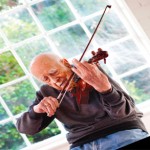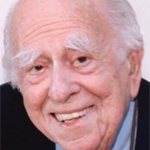
Editor’s note: This is the first in a recurring series of columns on the history of rheumatology that will highlight programs of excellence.
Whether preparing for a career in academics, clinical care, translational research or health services research, those who train in the Division of Rheumatology at the University of California San Francisco (UCSF) are rewarded with rich opportunities. Judging from the vibrancy of the division, its research programs and the success of program graduates, the division is living up to its stated mission to “advance the discipline of rheumatology through cutting-edge research and training of the next generation of academic rheumatologists.”
Several factors account for the 66-year-old program’s success, including a faculty comprising world-renowned physician-scientists, such as immunologist Art Weiss, MD, a member of the National Academy of Sciences and former chief of the division. Geneticist Lindsey A. Criswell, MD, MPH, DSc, the current division chief, conducts research that has advanced the understanding of the role of genetics in rheumatoid arthritis and systemic lupus erythematosus. The UCSF Rheumatology Division has received National Institutes of Health (NIH) Autoimmunity Center of Excellence grants for the past three funding cycles (totaling 16 years), as well as three consecutive cycles of NIH funding for its Multidisciplinary Clinical Research Center.

Cohesion across Sites
The Division offers a variety of clinical training opportunities at its four sites: the University of California Medical Center, the San Francisco Veteran’s Administration Medical Center, San Francisco General Hospital and the UCSF Laurel Heights campus. Despite their disparate locations and areas of research, division faculty foster program cohesiveness. That’s due, in no small part, to the genuine respect that all faculty have for one another, says David Wofsy, MD, professor of medicine and microbiology/immunology and associate director of the Rosalind Russell/Ephraim P. Engleman Rheumatology Research Center. “The scientists respect the clinicians, and the clinicians are interested in the science,” he says. “It’s all about the people, and if that tone [of respect] is genuine in your division, then new people adopt it when they come, too. It’s self-perpetuating.”
Mary Beth Humphrey, MD, PhD, division chief of rheumatology, immunology and allergy, University of Oklahoma Health Sciences Center, Oklahoma City, experienced this attitude firsthand when she trained as a fellow from 2001–2004. One example of the intentional cultivation of collegiality was the monthly evening journal club. “The entire basic research faculty and the clinical faculty, like Ken Fye and Ken Sack, would also be there,” she recalls. “I think it helped keep everyone from the four different campuses on the same page, despite the distance.”

The Funding Advantage
Strong financial support also bolsters the program’s depth. The division receives funding from the NIH, the Veterans Administration, the Northern California office of the Great Western Region of the Arthritis Foundation and private foundation funding from the Rosalind Russell/Ephraim P. Engleman Rheumatology Research Center.
The latter source—and one of the most important, according to Dr. Wofsy and Ephraim P. Engleman, MD, director of the center—blossomed because of Dr. Engleman’s work with the late Rosalind Russell and the National Arthritis Act’s Commission, which was established in 1974. Dr. Engleman had been a member of the UCSF Division since the 1940s and set up its first rheumatology clinic in 1947. In the 1960s, Rosalind Russell developed severe RA, and Dr. Engleman says she “complained bitterly” that few physicians knew very much about arthritis and that medical school training about arthritis was deficient.
Dr. Engleman got to know Ms. Russell “pretty well,” when she served as a public member of the Commission. She died in 1976; and three years later, in 1979, after several NIH site visits, The Rosalind Russell Center for Rheumatology Research was established. Creation of a fund-raising Board of Directors quickly followed, and in the 35 years that Dr. Engleman has been director, the foundation has supported five academic chairs in rheumatology, provided partial support for 130 rheumatology trainees and supplied supplemental funds for faculty members. (The name of the arthritis center at UCSF was recently changed to the Rosalind Russell/Ephraim P. Engleman Rheumatology Research Center.)
“We owe a debt of gratitude to the people before us,” says Dr. Wofsy of the philanthropic efforts of the Russell/Engleman foundation board. “In these economic hard times for academia, this support is even more important. It has enabled us to have a larger program than we would otherwise have had; and it has allowed us to be less dependent on the Department of Medicine for resources. As a result, we have an extremely good relationship with our department, which has partnered with us when there has been an opportunity for growth.”
Stellar Training
The first fellows were enrolled in the division’s Research Training Program in 1958. Since that time, 145 fellows have been trained in the program, which has been directed since 2005 by David I. Daikh, MD, PhD, professor of medicine, and Kenneth H. Fye Chair in Rheumatology. (Dr. Wofsy served as director of the training program from 1992 until 2005.) Dr. Daikh, who is also chief of rheumatology at the San Francisco VA Medical Center, believes that in addition to outstanding clinical training, the “No. 1 strength” of the three-year fellowship program—and of the division in general—is the strength of its faculty. This includes their broad range of research interests, from basic immunology to translational research and health services research, and their enthusiasm for teaching.
These were some of the elements that drew Andrew C. Chan, MD, PhD, to the program. During his fellowship at UCSF, he found that the mentorship “provided a nurturing but rigorous environment. It was a straight-talk, tough-science kind of environment that prepares one to be independent, to tackle science with a high degree of vigor and rigor, and to think about the big questions,” says Dr. Chan, who is currently senior vice president of research biology at Genentech. Through visiting professorships and oversight of an active post-doc mentoring program at Genentech, Dr. Chan sustains the mission of nurturing the next generation of researchers from which he benefitted as a doctoral fellow from 1989 to 1992.

Other program graduates have advanced that mission at their current institutions. For example, Dr. Humphrey and nine other graduates are chiefs of their divisions at other institutions. Others, like Dr. Chan, are active in industry as senior officers in other companies; and many have been awarded prestigious honors. Dr. Humphrey says she was always impressed with the selflessness of her mentors at UCSF. Conflicted about picking a research mentor, she consulted with Professor William Seaman, MD, who volunteered to supply career path mentorship to supplement her research work in Mary Nakamura’s osteoimmunology lab.
“I work very hard now to emulate what I was taught,” Dr. Humphrey says. “As my fellows and junior faculty are down in the dirt working on their research projects and trying to get published, I try to remember when they are eligible for an ACR fellow award or a travel grant to attend meetings of interest.”
On its own campuses and others where former trainees now train others, the effects of the UCSF Division of Rheumatology continue to grow. And the program shows no sign of slowing down, despite current economic challenges. “Success breeds success,” says Dr. Wofsy. “If you are able to develop a critical mass of outstanding trainees and faculty, other people want to come.”
Gretchen Henkel is a medical journalist based in California.
Author’s note: Dr. Engleman’s book, My Century, is available on Amazon; all proceeds from sales benefit the research center.

